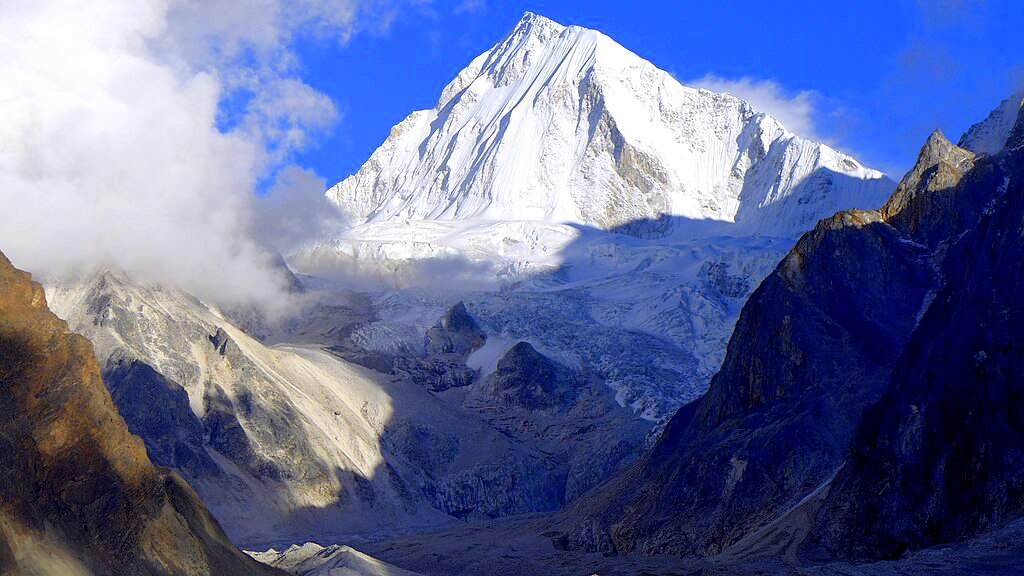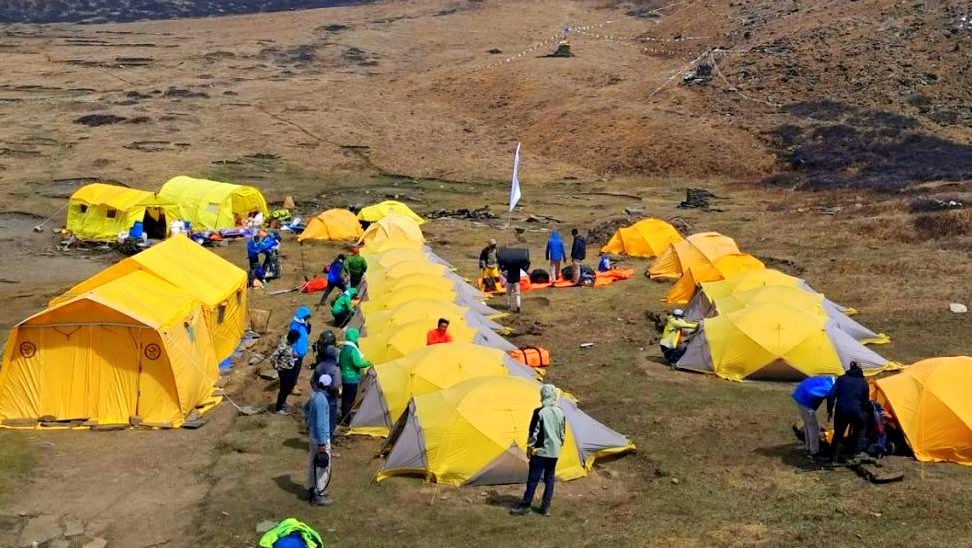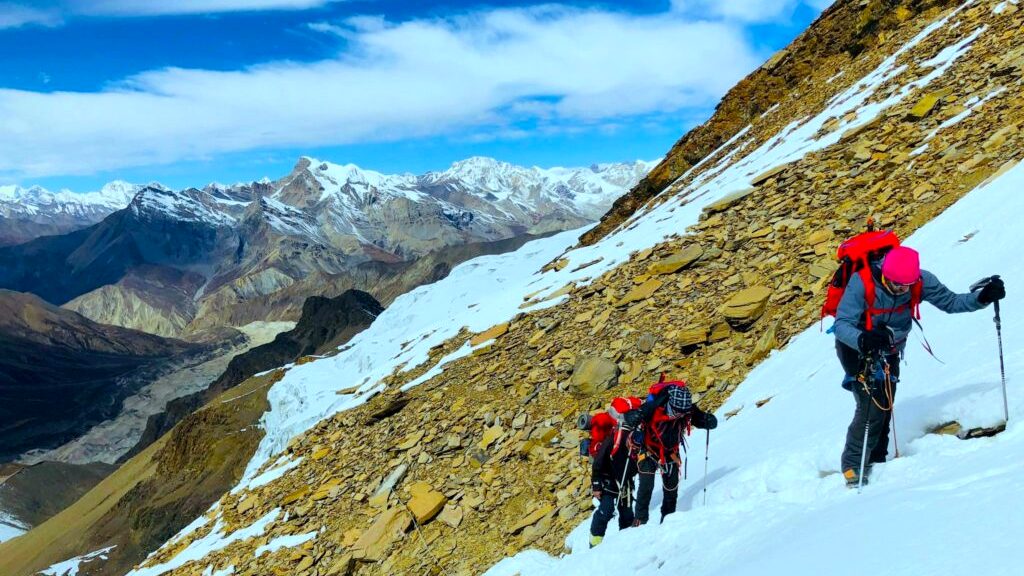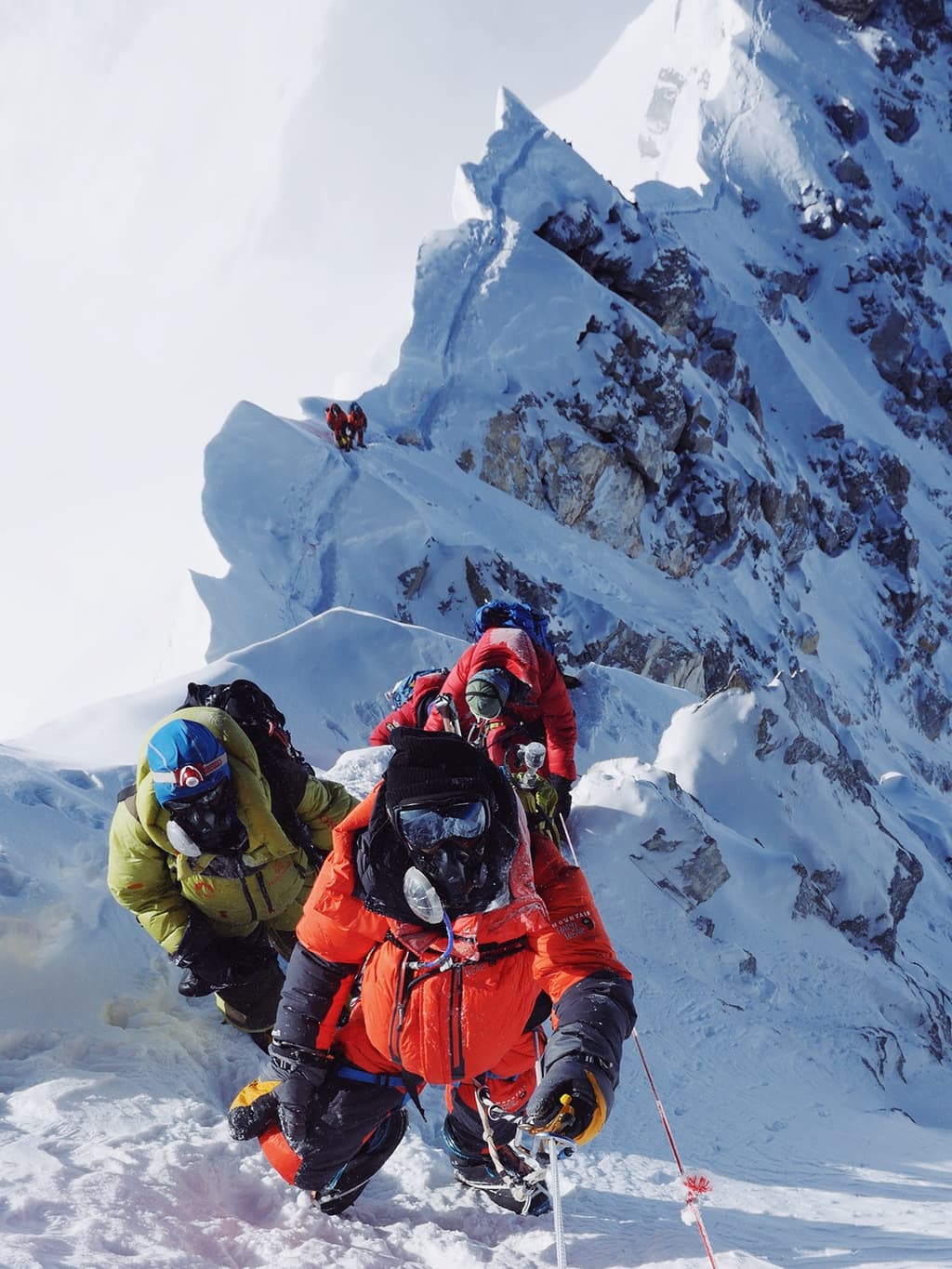Ever dreamed of climbing an 8000-meter peak but felt intimidated by the crowds on Everest? Himlung Himal might be your perfect adventure.
Tucked away in Nepal's remote Manaslu region at 7,126 meters, this mountain offers the authentic Himalayan expedition experience without the tourist traffic jams. Serious climbers are only now discovering this pristine peak with its breathtaking views and technical challenges.

I've guided dozens of expeditions to Himlung Himal, and I'll tell you this: the route combines just enough technical challenge with accessibility that makes it ideal for both seasoned mountaineers and ambitious first-timers ready to step beyond trekking peaks.
But what really separates Himlung from other 7000-meter climbs isn't just the mountain itself—it's what happens when you reach the summit ridge and see.
Discovering Himlung Himal: A Hidden Gem in the Nepal Himalaya
Geographic location and unique features
Tucked away in the remote Manaslu region of Nepal, Himlung Himal stands proud at 7,126 meters (23,379 ft). We often describe it as one of Nepal's best-kept mountaineering secrets. This magnificent peak sits in the Peri Himal range near the Nepal-Tibet border, about 70 km northwest of Manaslu.
What makes Himlung truly special is its position in a relatively unexplored corner of Nepal. The mountain rises from the dramatic landscapes of Naar-Phu valley, an area that only opened to tourists in 2002. When we trek to its base camp, we pass through traditional Tibetan villages, ancient monasteries, and pristine forests barely touched by outside influence.
The mountain itself features a distinctive dome-shaped summit with moderate slopes compared to other 7000ers. We've found its northwestern ridge offers the standard climbing route, with terrain that isn't overly technical but still demands respect and proper acclimatization.
History of exploration and first ascents
We can trace Himlung's climbing history back to 1992 when a Japanese expedition first conquered its summit. Led by Akio Tamura, their team pioneered what would become the standard route up the northwest face.
Despite its remarkable beauty, Himlung remained largely off the radar for years. We only started seeing regular expeditions in the early 2000s when Nepal's government officially opened the peak for climbing. The delayed discovery partly explains why the mountain retains such a pristine character.
Throughout its brief climbing history, Himlung has witnessed far fewer ascents than its famous neighbors. This limited traffic has preserved the mountain's natural character. We've seen growing interest in recent years, especially among climbers looking to prepare for 8000m peaks, but Himlung still feels like a genuine adventure rather than a commercialized climb.
Why Himlung Himal remains less crowded than other 7000m peaks
The magnificent isolation of Himlung is no accident. Several factors keep the crowds away, and we're honestly a bit grateful for that.
First, getting there demands commitment. The approach trek winds through remote valleys and takes 5-7 days from the nearest road. That's significantly longer than approaches to popular peaks like Island or Chulu East. This remoteness filters out climbers seeking convenient options.
Permit costs also play a role. We've seen that while Himlung's fees aren't exorbitant, they're higher than some other trekking peaks, positioning it in a middle ground that attracts serious mountaineers rather than casual peak-baggers.
Most importantly, Himlung simply hasn't developed the name recognition of peaks like Ama Dablam or even nearby Manaslu. The lack of publicity works in our favor - fewer climbers means more authentic experiences and less environmental impact.
For those of us who value wilderness over bragging rights, this is exactly what makes Himlung special. The mountain offers a true expedition feel that's increasingly rare in the Himalayas.
Essential Facts About Himlung Himal Expedition

Elevation and prominence details
At 7,126 meters (23,379 feet), Himlung Himal stands tall as one of Nepal's most alluring 7000ers. We've found this mountain offers the perfect balance between challenge and accessibility. While not as imposing as Everest or Cho Oyu, Himlung's prominence is significant enough to deliver breathtaking panoramic views of the surrounding Annapurna and Manaslu ranges.
The mountain rises dramatically from the remote Peri Valley, creating an impressive 1,800+ meter prominence that's visible for miles around. This substantial elevation gain from base camp to summit (approximately 3,000 meters) gives climbers the full mountaineering experience without the extreme altitude challenges of 8000ers.
Best seasons for climbing
We've learned through years of experience that timing is everything on Himlung. The pre-monsoon season (April-May) and post-monsoon season (September-October) offer the most stable weather windows for successful summit attempts.
Spring brings warmer temperatures and gradually improving conditions as the winter snows stabilize. Fall delivers the most reliable weather with clear skies and moderate temperatures, though slightly colder than spring. We typically avoid the summer monsoon (June-August) due to heavy precipitation and dangerous snow conditions, as well as the harsh winter months (November-March) when extreme cold and high winds make climbing nearly impossible.
Technical difficulty rating and comparison to other peaks
Himlung sits comfortably in the moderate difficulty range, making it perfect for those looking to step up from trekking peaks without jumping straight to extreme 8000ers.
|
Mountain |
Elevation |
Technical Difficulty |
Comparative Difficulty |
|
Himlung Himal |
7,126m |
Moderate |
Perfect stepping stone |
|
Island Peak |
6,189m |
Easy-Moderate |
Easier than Himlung |
|
Manaslu |
8,163m |
Difficult |
Significantly harder |
|
Cho Oyu |
8,188m |
Moderate-Difficult |
Somewhat harder |
We rate Himlung as PD+ (Peu Difficile Plus) on the Alpine scale. The route involves moderate snow slopes (30-45°), some crevassed sections requiring good rope management, and minimal technical ice climbing. The final ridge to the summit demands focus but lacks the extreme exposure found on more technical peaks.
Average expedition duration
We typically schedule our Himlung expeditions for 28-30 days door-to-door. This timeline gives us the breathing room needed for proper acclimatization, which is crucial for safety and summit success.
The breakdown usually follows this pattern:
-
3-4 days in Kathmandu for preparation
-
4-5 days trekking to base camp
-
15-18 days for acclimatization climbs and summit attempt
-
3-4 days return trek and travel to Kathmandu
This schedule includes multiple acclimatization rotations and built-in weather contingency days. We've found this timeframe maximizes summit chances while maintaining a reasonable expedition length compared to 8000ers, which often require 45+ days.
Planning Your Himlung Himal Adventure
Required permits and documentation
Getting the right paperwork sorted is crucial for our Himlung Himal expedition.
We always make sure our climbers have these essential permits:
-
Restricted Area Permit: Since Himlung Himal sits in a restricted region, this is non-negotiable
-
TIMS Card (Trekker's Information Management System): Required for all trekking in Nepal
-
Annapurna Conservation Area Permit (ACAP): Necessary as the approach route passes through this protected zone
We handle all the bureaucratic hassle for you, but you'll need to provide:
-
Valid passport with at least 6 months validity
-
4 passport-sized photos
-
Completed permit application forms (we'll guide you)
-
Proof of travel insurance with high-altitude coverage and evacuation
Recommended physical preparation and training
Truth bomb: Himlung isn't a walk in the park. We recommend a solid 4-6 month training program focusing on:
-
Cardiovascular endurance: Regular hiking with a loaded pack (start with 2-hour sessions, building to 6-8 hours)
-
Strength training: Especially legs and core, 2-3 times weekly
-
High-altitude acclimatization: Prior experience at 5000m+ is ideal
-
Technical climbing skills: Familiarity with crampons, ice axe, and rope techniques
Our most successful climbers mix long weekend hikes on steep terrain with weekday cardio and strength workouts. Don't skimp on stair climbing – it's boring but effective!
Essential gear and equipment checklist
The right gear can make or break your Himlung experience. Our essential packing list includes:
Technical Climbing Gear:
-
Mountaineering boots (double or triple)
-
Crampons (12-point minimum)
-
Ice axe and harness
-
Ascenders and descenders
-
Helmet and headlamp
Clothing Layers:
-
Down suit or heavyweight down jacket
-
Insulated pants
-
Multiple mid-layers and base layers
-
Waterproof outer shell
-
High-altitude mittens and liner gloves
Personal Equipment:
-
Expedition-rated sleeping bag (-30°C)
-
Insulated sleeping pad
-
UV-protective sunglasses (category 4)
-
Heavy-duty duffel bags
We provide group equipment like tents, cooking gear, and fixed ropes, but your personal kit must be top-notch.
Budget considerations and expedition costs
A Himlung expedition isn't cheap, but we've optimized our pricing to deliver maximum value. Our typical expedition costs include:
|
Expense Category |
Approximate Cost (USD) |
|
Permit fees |
$500-700 |
|
Guide services |
$4,500-6,000 |
|
Food and accommodation |
$1,200-1,800 |
|
Equipment rental (if needed) |
$800-1,500 |
|
Transportation in Nepal |
$400-600 |
Additional costs to factor in:
-
International flights to Kathmandu ($800-1,500)
-
Travel insurance ($300-600)
-
Personal gear purchases ($2,000-4,000 if buying new)
-
Tips for guides and staff ($300-500)
We recommend budgeting an extra $1,000 for contingencies, including potential helicopter evacuations not covered by insurance.
Vaccination and medical requirements
We take health seriously on Himlung. Before joining our expedition, we require:
-
Vaccinations: Hepatitis A & B, Typhoid, Tetanus, COVID-19
-
Medical check-up: Complete physical with your doctor, including ECG for climbers over 40
-
Prescription medications: Bring ample supply plus:
-
Diamox (for altitude sickness prevention)
-
Broad-spectrum antibiotics
-
Anti-diarrheal medication
-
Pain relievers
Our guides are Wilderness First Responder certified and carry comprehensive medical kits, including emergency oxygen. We also arrange for all climbers to attend a pre-expedition medical briefing in Kathmandu with an experienced expedition doctor.
The Himlung Himal Climbing Route

Standard route description and challenges
The Himlung Himal climbing route offers a perfect balance of challenge and accessibility. We begin our journey from Koto village, trekking through enchanting pine forests and crossing suspension bridges over the Naar Khola. The trail gradually ascends to Naar village where we spend time adjusting to the altitude.
From Naar, we trek to our Base Camp at 4,850m, which takes about 2-3 days depending on acclimatization needs. The real climbing begins as we establish Camp 1 at 5,450m on a relatively flat area after navigating through some moderately steep terrain with fixed ropes.
Camp 2 sits at around 6,000m and requires crossing a glacier with some crevasses – nothing too technical, but definitely requiring focus and proper rope techniques. The path between Camp 2 and Camp 3 (6,350m) presents the most technical section, with steeper ice slopes of 40-50 degrees.
The summit push from Camp 3 typically starts around midnight. We face a steep snow slope followed by a ridge walk with amazing views of Annapurna, Manaslu, and Tibet. The final section has a few technical moves before reaching the summit at 7,126m.
The main challenges we encounter include:
-
Hidden crevasses, particularly between Camps 1 and 2
-
Unpredictable weather patterns that can change rapidly
-
Sections of steep ice requiring solid crampon and ice axe skills
-
The thin air above 6,000m that tests even the strongest climbers
Base camp facilities and amenities
Our Himlung Himal Base Camp isn't just a stopping point – it's your mountain home for nearly two weeks. We set it up at 4,850m in a protected area with stunning views of the surrounding peaks.
The dining tent forms the heart of our Base Camp, equipped with tables, chairs, and a small heater for those chilly evenings. Here we serve three hot meals daily, prepared by our experienced mountain chefs who work magic with fresh ingredients we porter in. From traditional Nepali dal bhat to pasta and even occasional baked treats, the food keeps your energy high.
Your personal tent includes comfortable sleeping mats and is positioned to maximize protection from the elements. We also provide a communal charging station powered by solar panels for your devices.
The toilet facilities, while basic, are kept clean and well-maintained throughout your stay. Hot water is available for washing, though in limited quantities due to the remote location.
Our communication setup includes satellite phones for emergency use and sometimes Wi-Fi (weather and location dependent). The medical tent houses comprehensive first aid equipment and oxygen supplies, staffed by experienced medical personnel.
What makes our Base Camp special is the atmosphere we create – a place where climbers can rest properly, refuel, and mentally prepare for the challenges ahead.
Acclimatization strategy and rotation schedule
Smart acclimatization makes all the difference between summit success and disappointment. We've refined our rotation schedule over years of Himlung expeditions to maximize your body's adaptation while minimizing exhaustion.
After arriving at Base Camp, we spend 2-3 days resting and taking short hikes to nearby ridges. This crucial period allows your body to begin adjusting to the thin air before pushing higher.
Our typical rotation schedule follows this pattern:
-
First Rotation: Climb to Camp 1 (5,450m), spend one night, return to Base Camp
-
Rest Days: 2-3 days at Base Camp for recovery
-
Second Rotation: Climb to Camp 1, sleep one night, continue to Camp 2 (6,000m) for a few hours before returning to sleep at Camp 1, then back to Base Camp
-
Rest Days: 3-4 days at Base Camp (critical recovery period)
-
Third Rotation: Climb to Camp 2, sleep one night, possibly touch Camp 3 (6,350m) before returning to sleep at Camp 2, then back to Base Camp
-
Summit Preparation: 4-5 days of rest while watching for a good weather window
This "climb high, sleep low" approach triggers your body's production of red blood cells while preventing overexertion. We constantly monitor everyone's condition and adjust the schedule when needed – it's never one-size-fits-all on our expeditions.
Summit day expectations
Summit day on Himlung Himal is the culmination of weeks of preparation, and we make sure you know exactly what's coming. The adventure begins around midnight with a quick breakfast in Camp 3. This early start ensures we have enough daylight hours for both the ascent and safe return.
The initial hours involve navigating by headlamp across snow slopes, carefully following the fixed lines. The pre-dawn hours are often the coldest and most mentally challenging – this is when your inner strength really matters.
As sunrise approaches, we typically reach the shoulder around 6,800m, where breathtaking views provide a much-needed boost. The final ridge requires careful movement but rewards with increasingly spectacular panoramas of the Himalayan giants.
Most of our teams reach the summit between 8-11am, depending on conditions and pace. We limit summit time to about 30 minutes – enough for photos and celebration, but safety always comes first at this altitude.
The descent demands equal focus despite the euphoria. We aim to return to Camp 3 by mid-afternoon, though stronger climbers sometimes continue all the way to Camp 2 for a more comfortable night.
The entire summit day takes 10-14 hours round trip. While physically demanding, the technical difficulty is moderate compared to peaks like Ama Dablam or Everest. The real challenge is maintaining focus and energy at high altitude through a long day.
Everest Sherpa Expeditions' Specialized Approach
Our expedition leadership and expert Sherpa team
At Everest Sherpa Expeditions, we bring together the finest climbing talents in the Himalayas. Our team isn't just experienced – they're local legends who've grown up in the shadow of these mighty peaks. Most of our Sherpa guides have summited Himlung multiple times, with many boasting over 15 years of expedition experience across the Himalayas.
We keep our guide-to-climber ratio exceptionally low (1:2) to ensure personalized attention throughout your journey. This isn't just about safety – it's about creating a genuine connection with the mountain and our team.
Safety protocols and emergency procedures
The mountains don't care about your ambitions, and neither do we take chances with your safety. Our comprehensive safety system includes:
-
Daily weather monitoring with satellite communication systems
-
Oxygen reserves exceeding industry standards by 30%
-
Dedicated high-altitude medical kits at each camp
-
Emergency helicopter evacuation coordination
We've established a three-tiered communication system between base camp, advanced camps, and our Kathmandu office. Every expedition carries satellite phones and personal locator beacons for our clients.
Success rate and client testimonials
Our 85% summit success rate on Himlung speaks volumes, but the stories our climbers take home matter more to us.
"The difference was night and day. Other companies rush you up the mountain. Everest Sherpa Expeditions gave me time to acclimatize properly and truly experience the climb." – Maria K., Germany
"Their local knowledge and connections made everything smoother. I never felt like just another client." – James T., UK
Sustainable and ethical climbing practices
We weren't born into the climbing business – we were born into these mountains. That's why we:
-
Employ local staff at fair wages above industry standards
-
Remove all expedition waste (including historical garbage)
-
Use solar power at base camp
-
Support local education initiatives in mountain communities
We limit our group sizes to minimize environmental impact while maximizing your chances of summit success. The mountains have given us everything – giving back isn't optional, it's our responsibility.
Cultural Experiences Along the Journey
Local villages and communities encountered en route
The Himlung Himal trek isn't just about conquering peaks – it's about connecting with Nepal's heart and soul. We pass through some of the most authentic mountain villages you'll ever encounter, each with its own distinctive character.
Our journey typically takes us through charming settlements like Koto, Meta, and Phu. These ancient villages seem frozen in time, with stone houses clustered together against the harsh mountain elements. In Phu especially, we're always amazed by how the 200+ year-old monasteries still stand proud against the backdrop of towering peaks.
What makes this route special? Unlike the crowded Annapurna Circuit, these villages see few visitors. When we arrive, curious locals often invite us into their homes for butter tea. The genuine smiles we receive aren't practiced for tourists – they're the real deal.
Unique customs and traditions of the region
The Upper Mustang and Manang regions showcase Tibetan Buddhist culture in its purest form. We've watched elderly villagers spinning prayer wheels while reciting mantras, their weathered faces telling stories of mountain life.
Prayer flags flutter everywhere, sending blessings with each breeze. During our treks, we sometimes catch traditional dance performances where locals don colorful masks and costumes to depict ancient legends.
The food traditions here are fascinating too. We've shared meals of tsampa (roasted barley flour), thukpa (noodle soup), and momos (dumplings) – all prepared using recipes passed down for generations.
Opportunities for cultural immersion
Want to go beyond surface-level tourism? We make it happen. Our teams arrange homestays where you'll sleep in traditional homes, eat family-style meals, and experience daily mountain life firsthand.
We encourage our climbers to participate in local festivals if the timing aligns. The Lhosar (Tibetan New Year) celebrations are particularly spectacular, with monks performing elaborate ceremonies and families preparing special feasts.
Our local guides act as cultural bridges, translating not just words but meanings. They'll explain the significance behind prayer wheels, mani walls, and chortens that dot the landscape.
Many trekkers tell us these cultural experiences become their most treasured memories – even more than reaching the summit itself.
What Sets Himlung Himal Apart from Other Himalayan Climbs
Spectacular panoramic views of neighboring peaks
When you stand on Himlung Himal, the world opens up around you in ways few other peaks can match. We've guided countless climbers who were left speechless by the 360-degree panorama that unfolds from its slopes. The magnificent Annapurna range dominates one side, while the stark beauty of Tibet stretches across the other. On clear days, we can spot eight 7,000m+ peaks, including Manaslu, Annapurna I, and Dhaulagiri.
Unlike the crowded slopes of Everest or Cho Oyu, these views remain largely unspoiled by crowds of climbers. Our clients often tell us they had moments where they felt they had the entire mountain to themselves, drinking in views that seemed almost private.
Less commercial atmosphere and wilderness experience
We've watched with concern as some popular Himalayan routes have turned into highways of climbers. Himlung offers something different. The trails here see maybe 50-60 climbers annually compared to hundreds on more commercial routes.
The approach through remote Naar-Phu Valley gives our expeditions a true wilderness feel. Villages here maintain traditional Tibetan culture, largely untouched by tourism's influence. Base camp itself sits in splendid isolation, without the mini-cities of tents you'll find on more popular peaks.
Ideal preparation for higher 8000m expeditions
We've had many clients use Himlung as their stepping stone to 8000m peaks, and for good reason. At 7,126m, it demands respect without the extreme challenges of the world's highest mountains.
The technical sections on Himlung mirror what climbers face on higher peaks:
-
Fixed rope techniques on 45-50° slopes
-
Crevasse navigation
-
Camp establishment in extreme conditions
-
Acclimatization protocols similar to 8000m climbs
The mountain gives climbers a perfect testing ground without the extreme altitude risks of 8000ers. Our success rate on subsequent Everest expeditions is noticeably higher among those who've trained with us on Himlung first.
Photographic opportunities and natural highlights
As photographers ourselves, we're consistently blown away by Himlung's visual offerings. The mountain rises from lush valleys through alpine meadows before reaching the stark beauty of its glaciated upper slopes.
Dawn on Himlung brings a light show that professional photographers dream about - the golden glow hitting Annapurna and Manaslu while our slopes remain in cool blue shadow. The contrast between the turquoise waters of high-altitude lakes and the snow-capped peaks creates images that define many climbers' portfolios.
Wildlife sightings add another dimension to the expedition. Blue sheep navigate impossible slopes with ease, and if you're lucky, the elusive snow leopard might make a distant appearance. Even the night skies deliver, with minimal light pollution creating starscapes you can almost touch.
Embarking on a Himlung Himal expedition offers the perfect balance of technical challenge and pristine wilderness for climbers seeking an alternative to crowded Himalayan peaks. At 7,126 meters, this mountain rewards adventurers with spectacular views and a genuine expedition experience while passing through culturally rich villages that showcase Nepal's diverse heritage. With proper planning, physical preparation, and the right team, this hidden gem becomes an achievable summit for experienced mountaineers.
Everest Sherpa Expeditions brings decades of local expertise to your Himlung Himal journey, providing comprehensive support from Kathmandu to the summit. Our specialized knowledge of the region's terrain, weather patterns, and cultural nuances ensures both your safety and an enriching experience beyond just the climb. Whether you're expanding your 7000m peak collection or seeking a less-commercialized Himalayan adventure, Himlung Himal awaits as your next remarkable achievement in the heart of Nepal's majestic mountains.
If you need any further information, please contact us by email: [email protected], Phone: +977- 980 195 6248 (WhatsApp).


